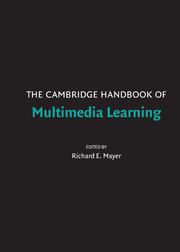Book contents
- Frontmatter
- Contents
- Preface
- Contributors
- 1 Introduction to Multimedia Learning
- PART I THEORETICAL FOUNDATIONS
- PART II BASIC PRINCIPLES OF MULTIMEDIA LEARNING
- PART III ADVANCED PRINCIPLES OF MULTIMEDIA LEARNING
- PART IV MULTIMEDIA LEARNING IN CONTENT AREAS
- PART V MULTIMEDIA LEARNING IN ADVANCED COMPUTER-BASED CONTEXTS
- 31 Multimedia Learning with Animated Pedagogical Agents
- 32 Multimedia Learning in Virtual Reality
- 33 Multimedia Learning in Games, Simulations, and Microworlds
- 34 Multimedia Learning with Hypermedia
- 35 Multimedia Learning in e-Courses
- Author Index
- Subject Index
- References
31 - Multimedia Learning with Animated Pedagogical Agents
Published online by Cambridge University Press: 05 June 2012
- Frontmatter
- Contents
- Preface
- Contributors
- 1 Introduction to Multimedia Learning
- PART I THEORETICAL FOUNDATIONS
- PART II BASIC PRINCIPLES OF MULTIMEDIA LEARNING
- PART III ADVANCED PRINCIPLES OF MULTIMEDIA LEARNING
- PART IV MULTIMEDIA LEARNING IN CONTENT AREAS
- PART V MULTIMEDIA LEARNING IN ADVANCED COMPUTER-BASED CONTEXTS
- 31 Multimedia Learning with Animated Pedagogical Agents
- 32 Multimedia Learning in Virtual Reality
- 33 Multimedia Learning in Games, Simulations, and Microworlds
- 34 Multimedia Learning with Hypermedia
- 35 Multimedia Learning in e-Courses
- Author Index
- Subject Index
- References
Summary
Abstract
In this chapter, I review the theoretical and empirical work on the use of animated pedagogical agents (APAs) in multimedia learning. After defining APAs and reviewing some of the existing applications, I present a cognitive theory of multimedia learning (CTML) from which predictions for APA design are derived. More specifically, I contrast the potential beneficial and detrimental effects for using APAs in interactive multimedia environments. Then, I provide a critical analysis of the literature summarizing what we know about APAs and discuss the implications of this research for instructional design. Finally, I explore future directions for advancing our understanding about the role of APAs in multimedia learning.
Introduction
The goal of this chapter is to review the theoretical and empirical work on the use of animated software pedagogical agents (APAs) in multimedia environments and to propose directions for future research based on a cognitive theory of multimedia learning (CTML). Multimedia instructional environments are widely recognized to hold great potential for improving the way that people learn (Mayer, 2001). Examples of multimedia environments for science and math learning are abundant and usually combine a description of a complex system or procedure in written or spoken words along with corresponding illustrations or animations depicting the system. This format of instruction, when made concise and coherent, has been shown to be effective in fostering student understanding as indicated by performance on solving problem-solving transfer questions (Mayer & Moreno, 2003).
- Type
- Chapter
- Information
- The Cambridge Handbook of Multimedia Learning , pp. 507 - 524Publisher: Cambridge University PressPrint publication year: 2005
References
- 61
- Cited by

